If you buy through our links, we may earn an affiliate commission. This supports our mission to get more people active and outside.Learn about Outside Online's affiliate link policy
The Best Backpacking Packs for Multiday Adventures (2025)
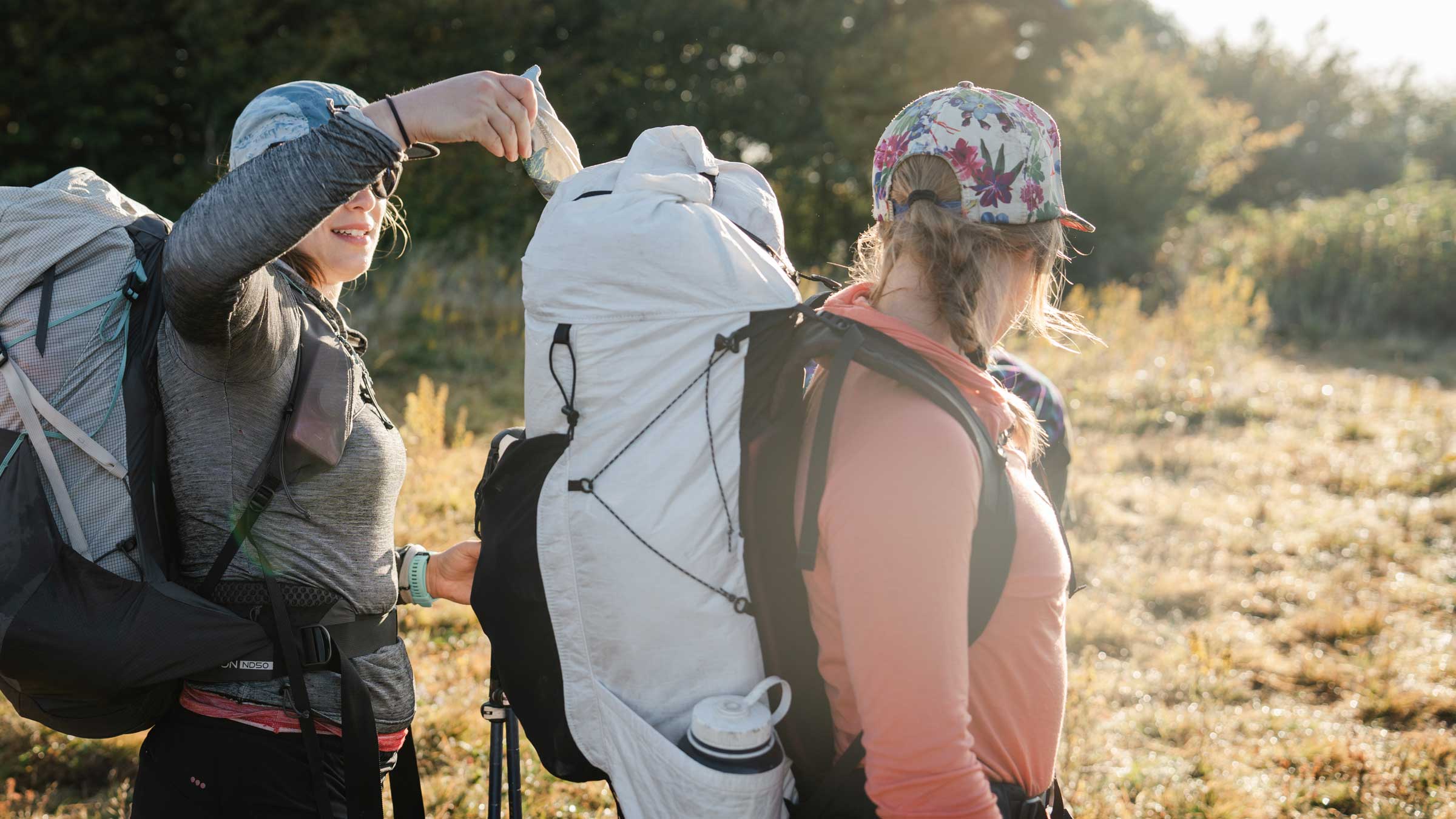
(Photo: Evan Green)
Table of Contents
Your tent may be your backcountry bedroom, but your multiday pack is your home away from home. What else would you call the thing that contains your kitchen, living room, bedroom, powder room, and pantry? And if you’re going to be carrying your home on your back, you better be sure it’s worth the weight.
As with any house-hunting mission, choosing a backpacking pack is a serious endeavor. Consider us your Zillow: We’ve spent years poring over the best options on the market, trying them out, and ranking them according to price, features, comfort, and load-carrying capacity. The ten reviewed below are the best you’ll find anywhere. Whether you want to get off grid for a night or a fortnight, you can trust that these top haulers have the chops to carry all the essentials—and then some. Here are the best backpacking packs of 2025.
At a Glance
- Best All-Around: Gregory Paragon 60/Maven 58 ($300)
- Best for Beginners: Rab Exion 55 ($250)
- Lightest: Big Agnes Sweetwater UL 43 ($280)
- Most Durable: REI Co-op Traverse 60 ($269)
- Most Versatile: Pingora Outro 55 ($230)
- Biggest: Deuter Aircontact Pro 75+10 ($360)
- Most Eco-Friendly: Fjällräven Abisko Trek 65 ($295)
- Best Organization: Mystery Ranch Radix 57 ($299)
- Best for Bigger Bodies: Osprey Rook/Renn 65L Extended Fit ($200)
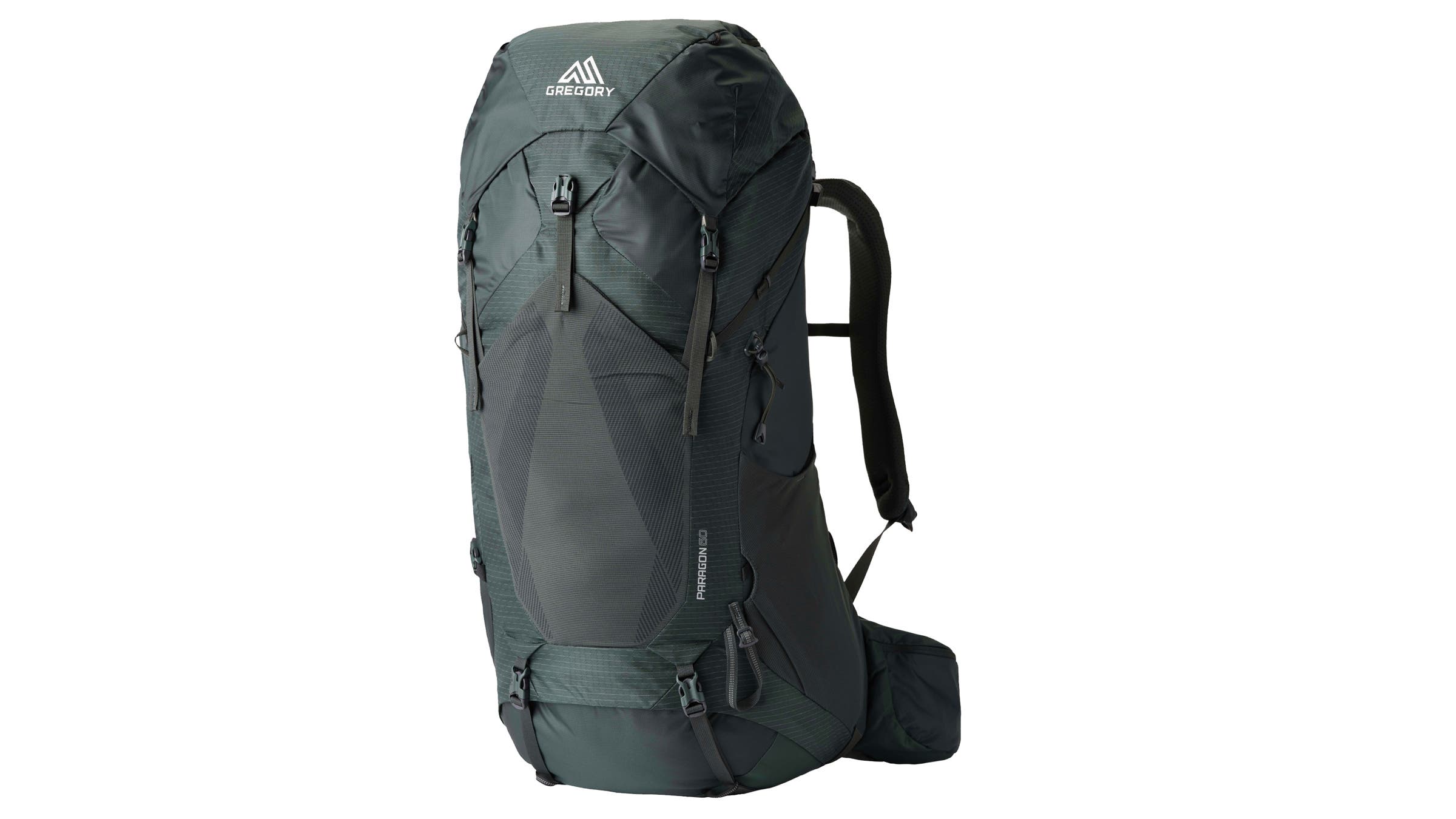
Best All-around
Gregory Paragon 60/Maven 58
Lab-Tested Weight: 3 lbs, 12 oz (Paragon S/M)
Lab-Tested Volume: 67.5 L and two 1 L bottle pockets
Lab-Tested Comfortable Load Capacity: 40 lbs
Sizes: Men’s Paragon S/M – M/L ; women’s Maven XS/S – S/M
Pros and Cons
+ Sway-free carry
+ Decent breathability
+ Recycled fabric
– No rain cover
– Not the most durable
When we gave the Paragon 48/Maven 45 an Editor’s Choice award in 2020, we were sure this pack was as good as it was ever going to get thanks to its comfort, load-carrying capacity, and an organizational system Marie Kondo would be proud of. But with improvements across the board, the newest version has proven us wrong.
Testers loved the seamless, EVA-padded, wrap-around harness, which hugs the hips for hot-spot-free carry. As with most Velcro backpanel adjustment systems, this one was a little tricky to manipulate, but let us expand the back length by up to three inches. A steel perimeter frame let us carry up to 40 pounds comfortably on Mt. Rainier, and a new, foam-free, honeycombed mesh backpanel permitted enough airflow that we didn’t swamp out, even on the 5,000-foot descent with temps in the 70s.
Carry was surprisingly smooth and we never experienced pack sway, even during extended bushwhacks in Idaho’s Panhandle National Forest, thanks to the floating hipbelt. “It stayed secure even when I was crawling on my hands and knees under deadfall,” reported tester Jim Pierce. One bummer: While the updated, 40-percent recycled, 210-denier nylon main fabric was durable enough to withstand clawing branches, the 330-denier boot sustained a few pinprick holes during a 100-foot butt scoot along a narrow mountain ridge.
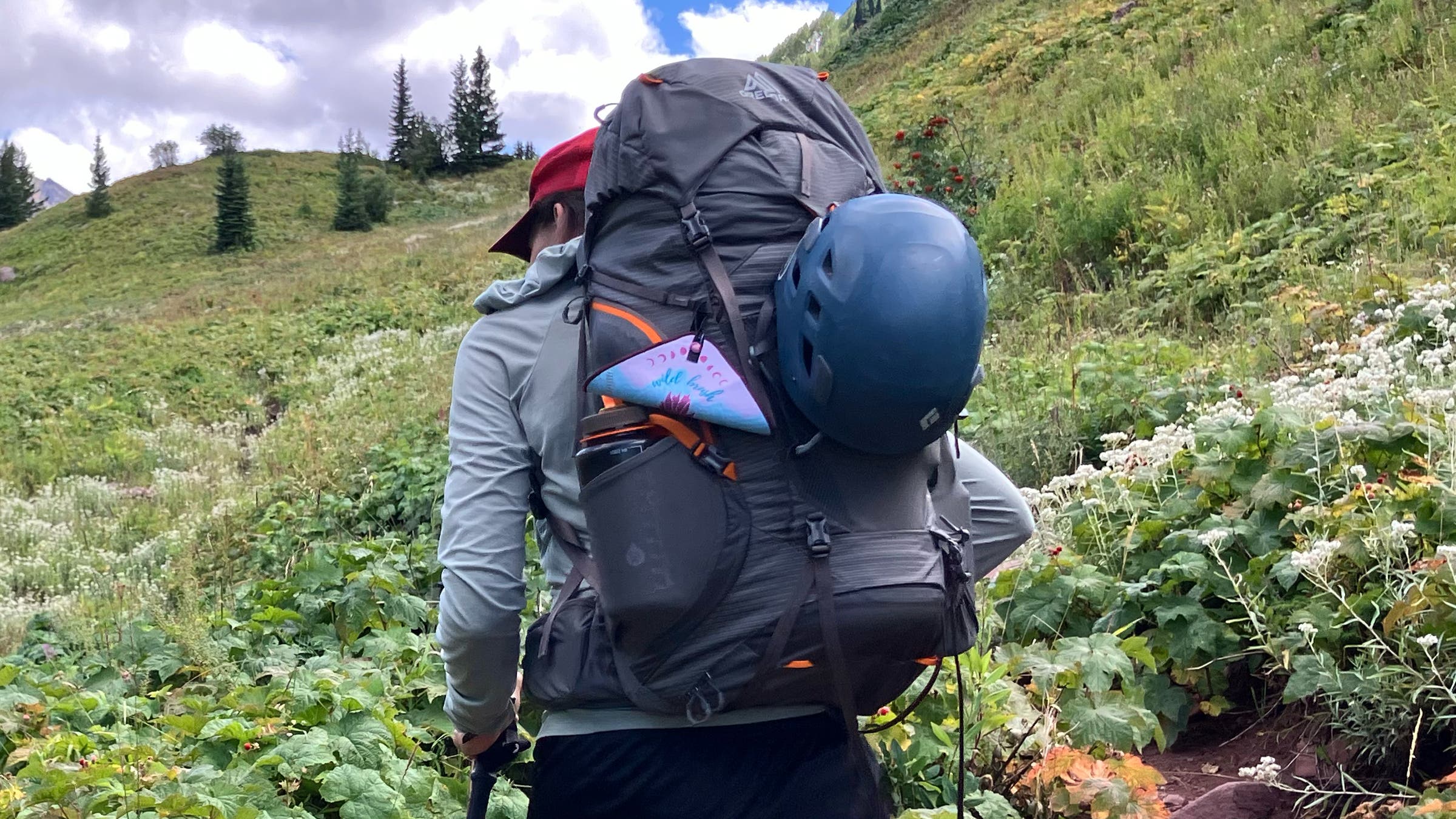
Organization ticks all the standard boxes. A single shoulder-strap pocket fits a pair of sunglasses, and a full-length external zipper permits main compartment access. Dual hipbelt pockets each fit a smartphone (though larger models were a bit of a squeeze), and twin side bottle pockets are now slightly easier to reach mid-stride thanks to a new forward opening (though bottles can be tough to fit when the pack is stuffed full). Testers also loved the roomy top lid and dorsal shove-it pocket, which features a single-way stretch mesh, allowing the pocket to swell laterally without compromising durability (the way four-way-stretch materials do).
Between the materials overhaul, smart feature updates, and significantly enhanced comfort, this is a serious upgrade. So allow us to revise our previous assertion: the former Paragon/Maven could indeed be improved. And while this one still has a few small growth areas, it’s quickly closing in on perfection.
Read our extended review of the Gregory Paragon 60/Maven 58 here
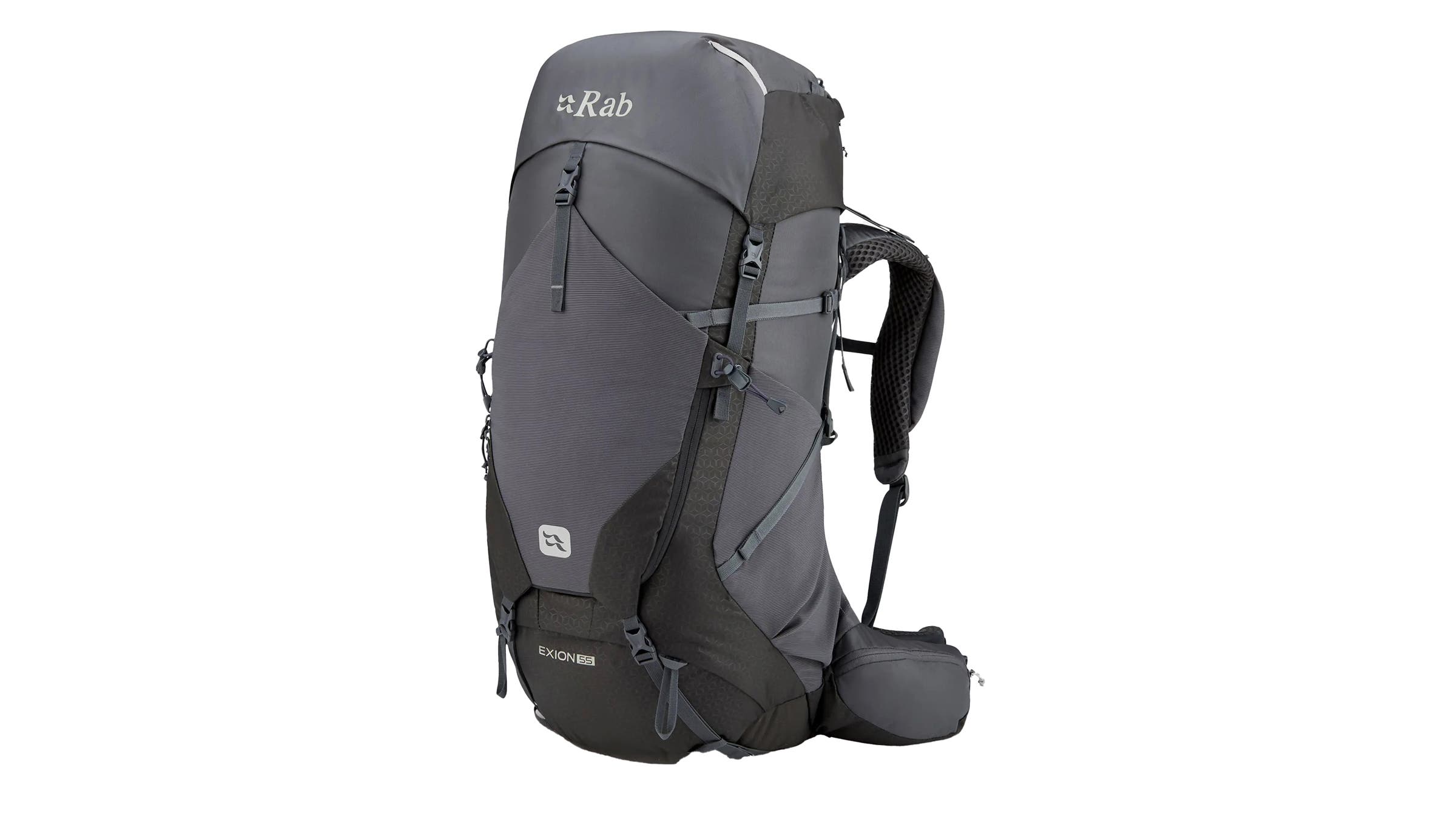
Best for Beginners
Rab Exion 55
Lab-Tested Weight: 4 lbs, 8 oz (men’s S/M)
Lab-Tested Volume: 63 L and two 1 L bottle pockets
Lab-Tested Comfortable Load Capacity: 35 lbs
Sizes: M’s regular and L/XL, W’s regular
Pros and Cons
+ Comfortable
+ Durable
+ Good organization
– Heavy
– Adjustable, but only comes in one size
Long-distance hiking is hard enough without having to endure an ill-fitting pack. The Exion all but eliminates that concern with a thickly-padded hipbelt and shoulder straps that are ergonomically contoured to hug the body. It felt cozy right out of the box, and testers never complained of rubbing or chafing, even after a full season of guiding and backpacking across Arizona and Colorado. Between the five-star comfort, a reasonable price point, and an interior capacity that’s just right for a long weekend, the Exion quickly became our top pick for new backpackers this season.
The Exion sports a 40-pound carrying capacity, which gives new hikers plenty of margin for error while they’re optimizing their packing lists. Tester and guide Jeanelle Carpentier was able to lug up to 44 pounds for a long water carry in the Grand Canyon without undue strain (though she recommends slightly less weight for maximum comfort). Likewise, the sheer number of pockets makes it easy to dial-in your organizational system when you’re new to backpacking. The water bottle pockets were accessible mid-stride, and the large hipbelt pockets each fit a phone or several granola bars. The twin chest pockets were slightly smaller, but still large enough to keep sunscreen, lip balm, and a headlamp at the ready. The back of the pack boasts both a shove-it sleeve for rain layers and a bottom-access zipper for sleep gear.
While the pack did get swampy when temps topped 90°F, thick mesh lining the hipbelt and backpanel helped wick away some sweat and prop the pack slightly off the back, allowing for light airflow. The rest of the pack held up equally well to the rigors of hard hiking; the 330-denier nylon exterior and 600-denier canvas base resisted abrasion both from granite talus in the high Rockies and sand-blasting wind in the desert.
Our biggest complaint was that the women’s pack comes in only one size. The hook-and-loop backpanel system was easy enough to adjust in the field and had enough range to accommodate testers ranging from 5’6” to 6’1”. However, women on the lower end of the height spectrum complained that the backpanel was still too tall to tilt their heads back comfortably; they would have preferred a second, smaller backpanel option.
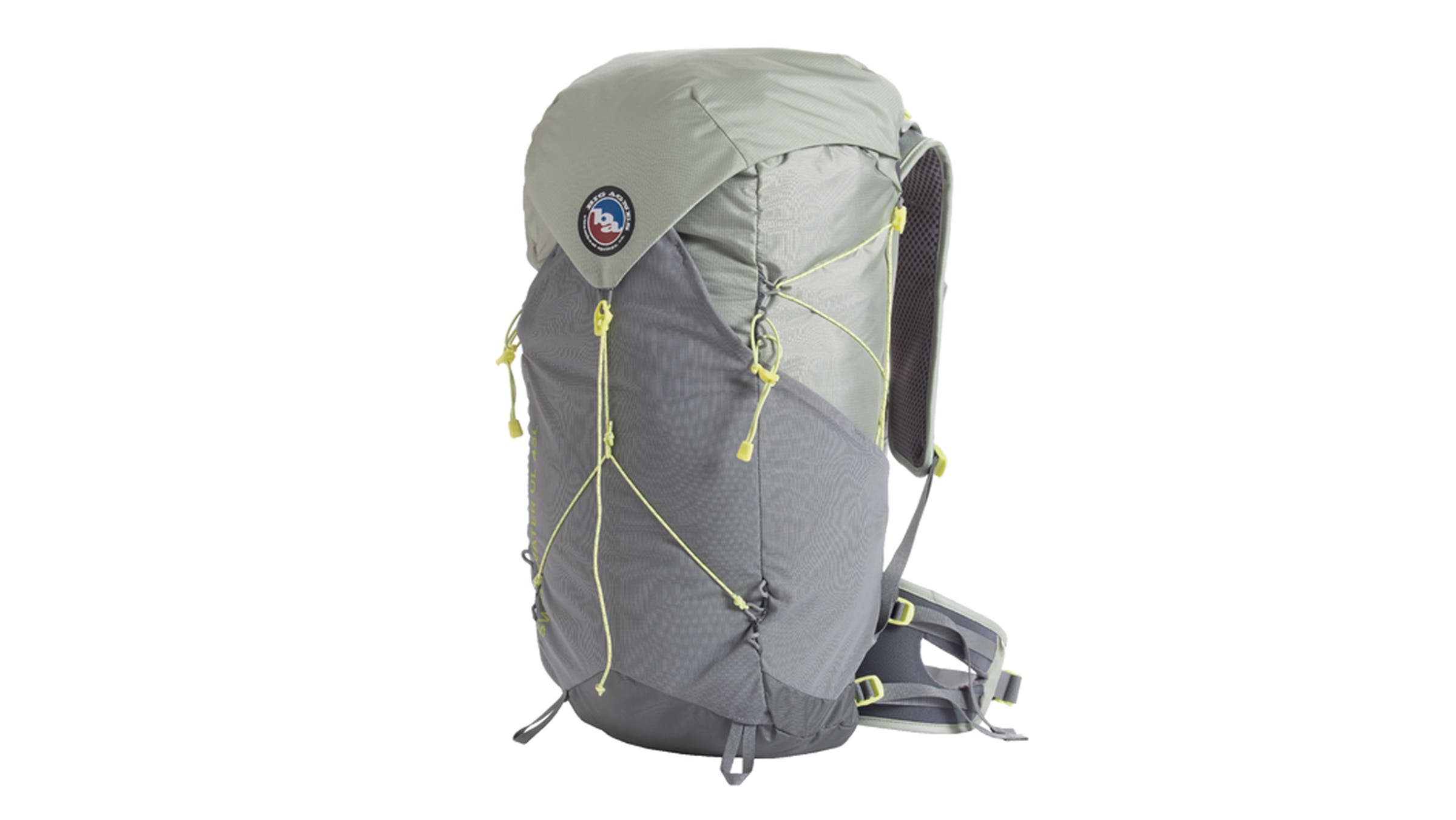
Lightest
Big Agnes Sweetwater UL 43
Lab-Tested Weight: 2 lbs, 12 oz (Unisex M)
Lab-Tested Volume: 45 L and two 3 L bottle pockets
Lab-Tested Comfortable Load Capacity: 30 lbs
Sizes: Unisex S-L
Pros and Cons
+ Even weight distribution
+ Lightweight
+ Generous chest pockets
– No hipbelt pockets
A clever mashup between a running vest and a backpacking pack, this sleek little number was built for hikers who like to go fast and far. Broad shoulder straps on the vest-style harness distribute weight evenly across the chest and shoulders, and dual sternum straps—common on running vests but rare on multiday packs—keep loads snugged securely to the trunk. While there’s no frame, a stiff, injection-molded framesheet and load-lifter straps let us pack the Sweetwater UL with up to 30 pounds of overnight gear.
The other benefit of those broad shoulder straps? Huge chest pockets. While there are no hipbelt pockets, we were able to store a phone, personal locator beacon, sunscreen, and an entire day’s worth of snacks upfront. That meant testers never had to stop and doff the pack during breaks—a blessing when one got caught in a freak snowstorm in the Italian Dolomites. Not only was he able to stay moving when it was too cold to stop, but the pack’s included raincover and DWR coating were more than sufficient to weatherproof his gear.
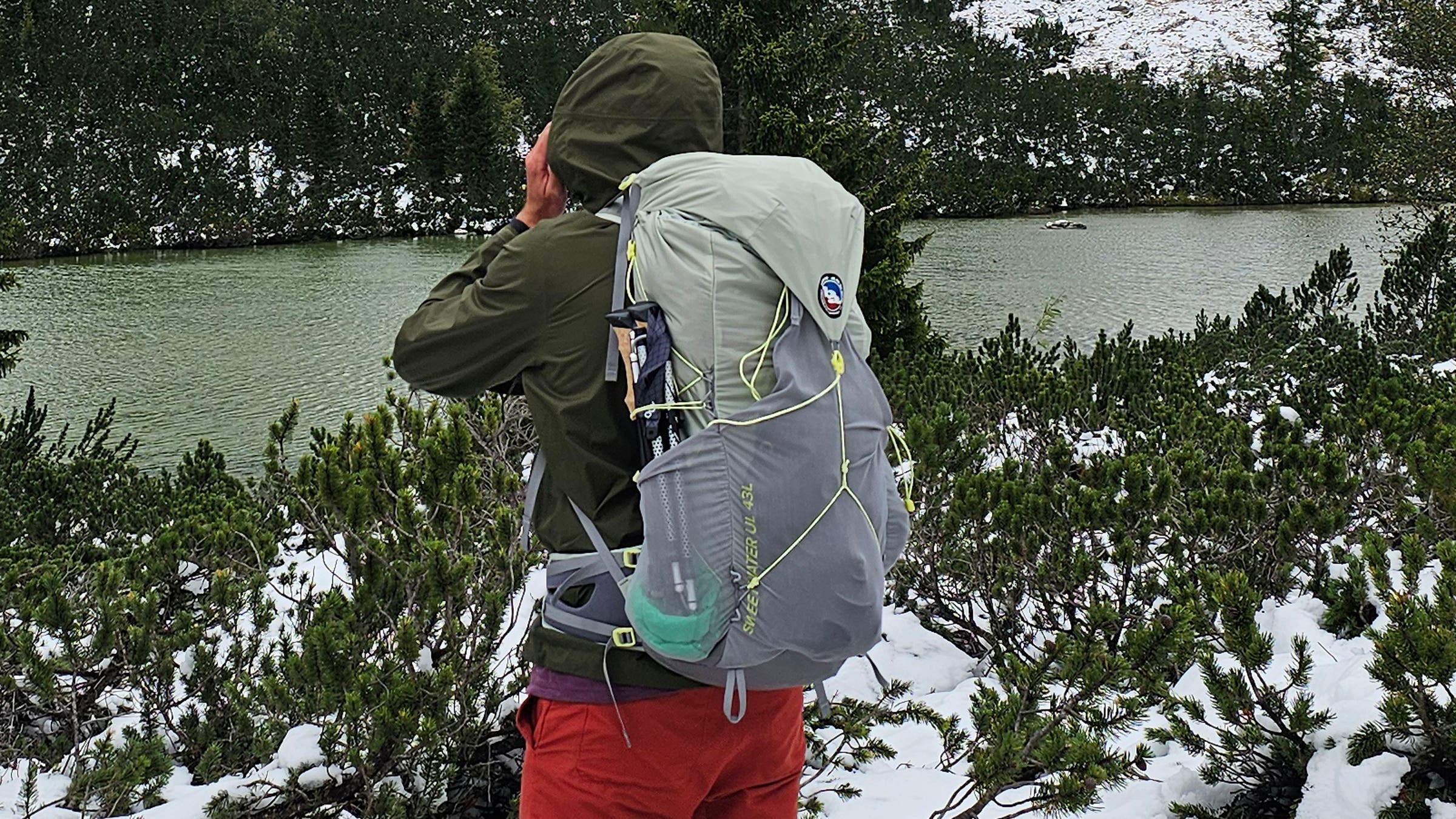
“The raincover is extremely thin—I was sure I would have wet gear,” said tester David Perillo. “But the cover kept the bag totally dry.” He also worried about the gossamer mesh on the lateral pockets and straps, but it shrugged off even the roughest treatment. Perillo was able to sling the Sweetwater UL around on planes and trains and toss it against ice and rocks. It emerged without any runs in the mesh or damage to the pack body.
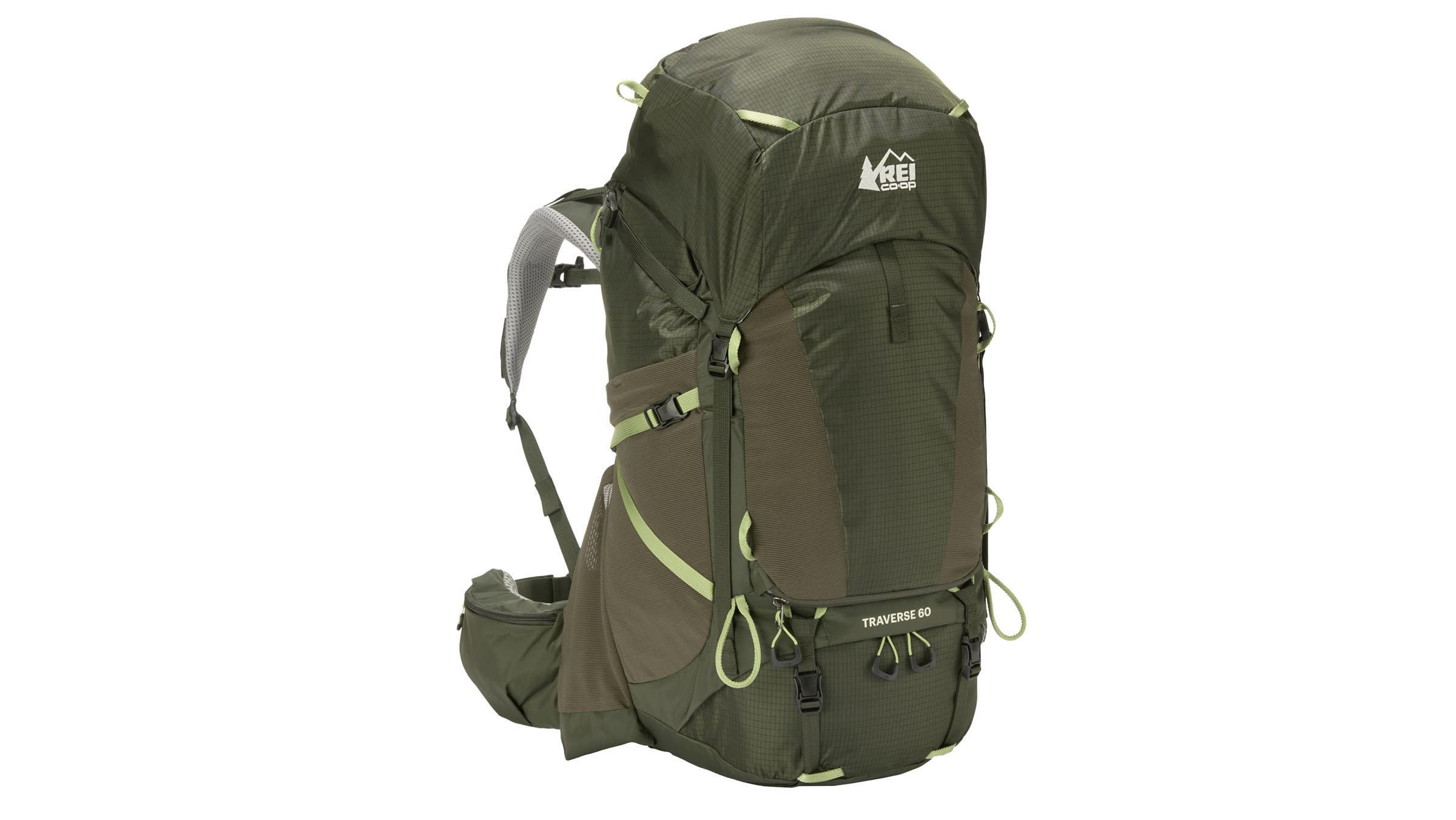
Most Durable
REI Co-op Traverse 60
Lab-Tested Weight: 4 lbs, 6 oz (men’s S/M)
Lab-Tested Volume: 65.5 L and two 1 L bottle pockets
Lab-Tested Comfortable Load Capacity: 30 lbs
Sizes: Men’s S-3X; women’s XS-3X
Pros and Cons
+ Comfortable
+ Excellent durability
+ Budget-friendly price
– Not very breathable
Outstanding comfort and durability (and a reasonable pricepoint) made this our go-to recommendation for rugged terrain this season. Over the course of a five-month testing season, we put the Traverse on professional guides and absolute beginners alike, and every one of them was impressed.
“This bag is a combination of all the best features from every pack I have ever owned,” summed up one tester. The Traverse sports four inches of adjustability, twin hipbelt pockets, a hydration sleeve, and a mesh pouch on either side—each big enough for a Nalgene. Trekking guide Samantha Cooke used the generous dorsal sleeve for her map, emergency gear, and bathroom supplies, and she was grateful for the bottom-access zipper, which let her quickly grab a first-aid kit when a client took a spill.
Plus, she never had to think twice about throwing in extra gear: the aluminum perimeter frame easily carried up to 40 pounds, including enough food and first aid for seven guests on a trip in Bryce Canyon, Utah. “It was extremely comfortable,” Cooke reported. “I felt like I was being hugged by the hipbelt, and the backpanel was very cush. It hit all the right places.”
The Traverse’s 210-denier ripstop nylon wasn’t the burliest in test, but it never ripped or tore, even after 100 miles of testing and a number of scrapes in rough sandstone canyons. The fabric also sports a durable water-repellant coating, which deflected light drizzle and even kept our gear dry after partial submersion in Zion’s narrows.
The only downside: The Traverse’s heavily padded backpanel isn’t very breathable. “I was soaked in back sweat more often than not,” Cooke said.
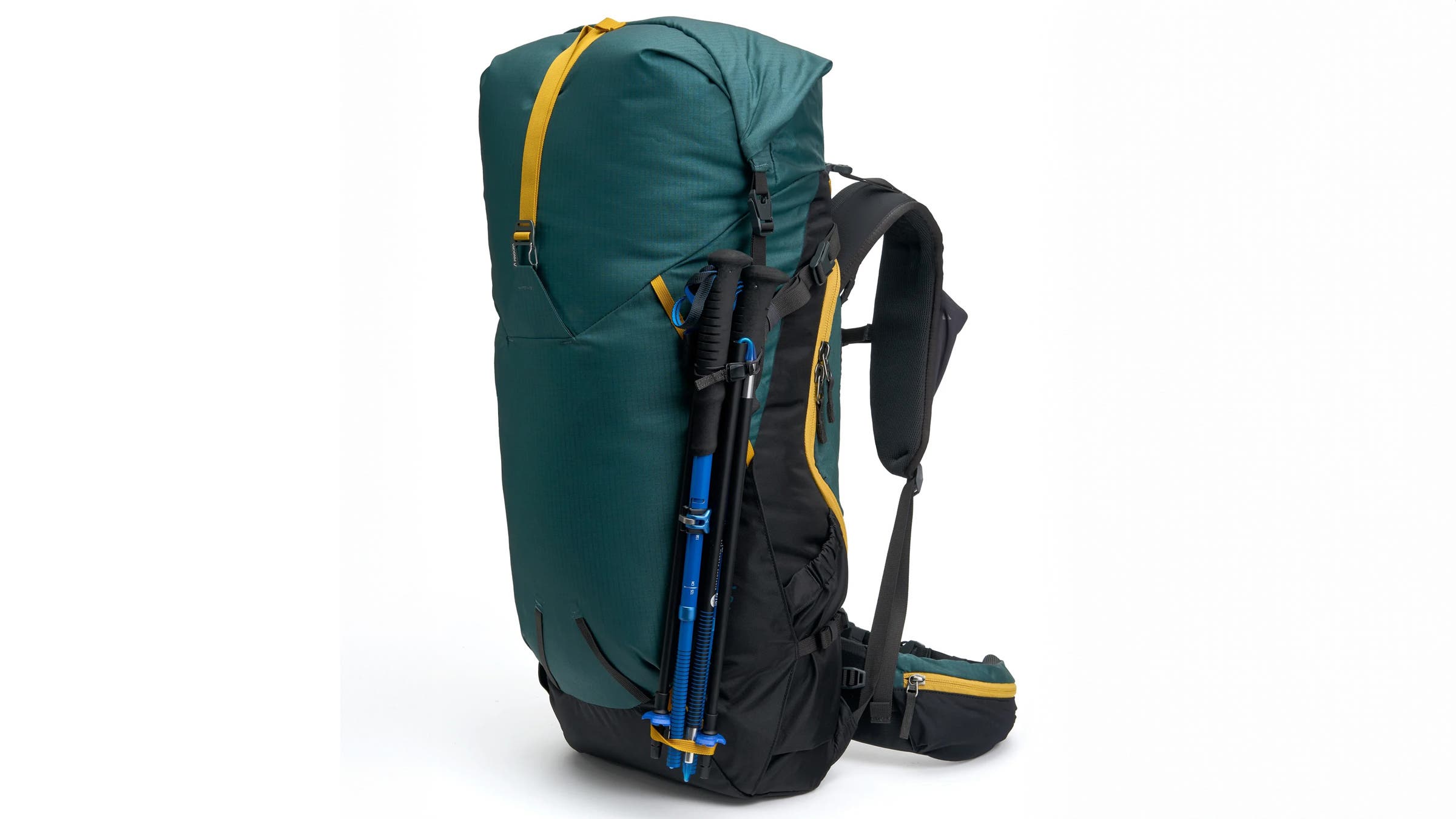
Most Versatile
Pingora Outro 55
Lab-Tested Weight: 4 lbs (Unisex M)
Lab-Tested Volume: 55.75 L and two 1 L bottle pockets
Lab-Tested Comfortable Load Capacity: 35 lbs
Sizes: Unisex S-L torso and S-L belt
Pros and Cons
+ Customizable fit
+ Good durability
– Shoulder harness was too wide for some testers
– Not water-resistant
Need a weekend bag? An alpine climbing pack? A four-season day-hiker? The Outro aims to please. From bushwhacking to alpine scrambling, this chameleon of a bag has enough modular features to suit just about any adventure need.
Two lateral pockets each fit a SmartWater bottle, and while we could fish the bottle out without removing the pack, we always needed a friend to stuff it back in. Inside the bag, a zippered interior divider splits the pack into in-camp and on-trail compartments. The three-liter toplid can also be converted to a day pack for peakbagging side-quests. Four chest pockets and two hipbelt pockets allowed testers to keep snacks and sunscreen within reach while scrambling in Rocky Mountain National Park, and a double set of loops and bungees made it easy to stash trekking poles or an ice axe for hands-on terrain. The pack’s streamlined silhouette and back-contouring aluminum frame kept 30-pound loads close, preventing sway even on technical ridges.
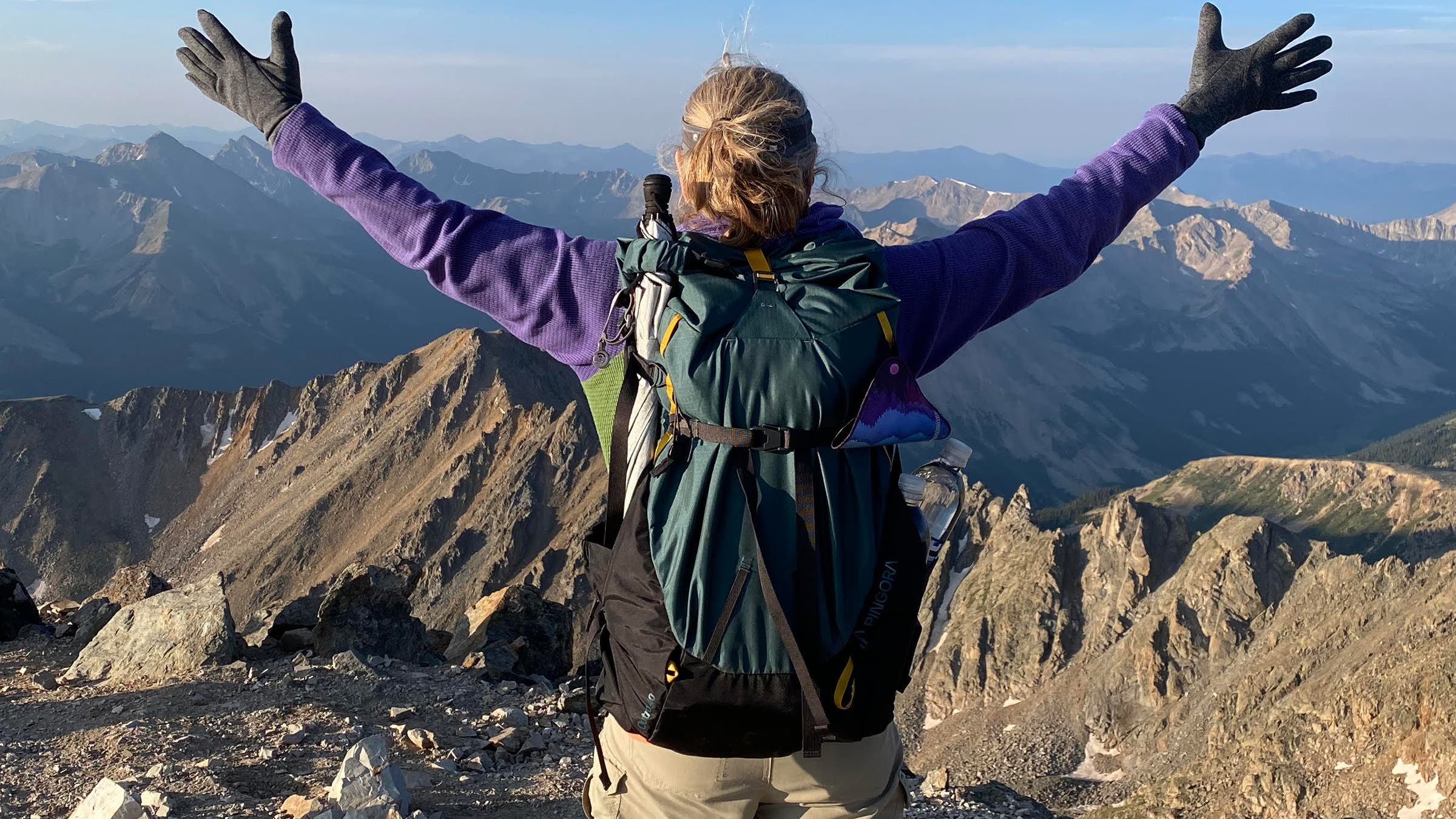
But the Outro isn’t just an adventure chameleon. It also shape-shifts to fit different users. Unlike other bags, which tend to be serviceable at either end of their adjustment range but have a real sweet spot in the middle, the Outro 55 is designed to preserve its shoulder-harness geometry throughout. Pingora achieved this by moving the adjustment mechanism to the bottom of the backpanel. This system maintains optimal load-lifter angle at every size. The Outro is also customizable: upon ordering, you can pick your hipbelt size and choose whether to add the toplid. (However, there’s no option for width adjustment. Some female testers and those with narrow shoulders found it too wide for comfortable carry.)
Of note: The pack isn’t particularly water-resistant, and some testers had issues with wet gear after torrential Alaskan rainstorms. However, the pack’s 420-denier nylon body fabric (210 on the roll-top) proved plenty durable during bushwhacks. “I was determined to find some solitude on a busy weekend hike near Pear Lake in Rocky Mountain National Park,” reported tester Robin Mino. “The pack held up well—not even a scratch on the fabric despite plowing through lots of brush.”
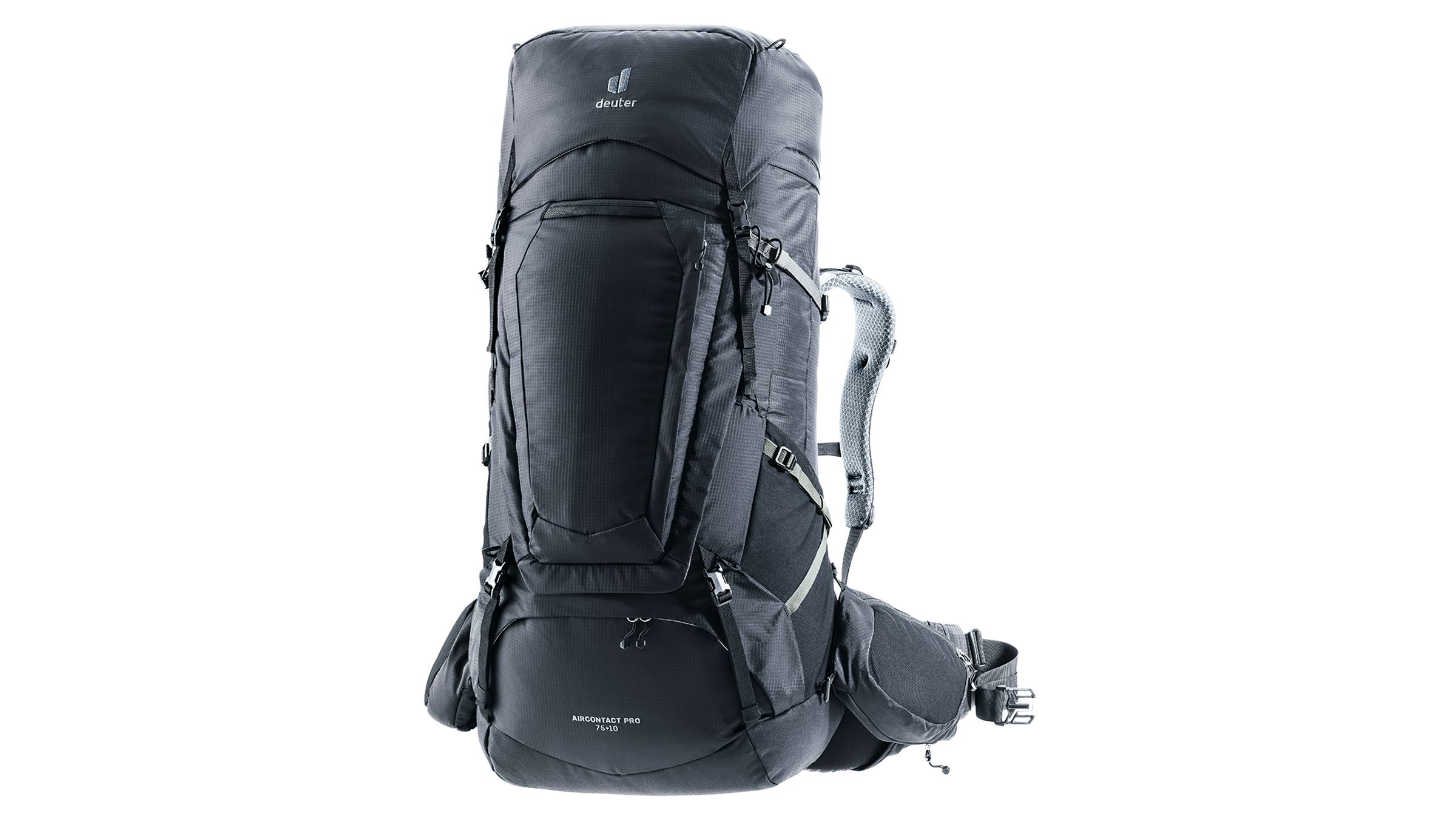
Biggest
Deuter Aircontact Pro 65+10 SL / 75+10
Lab-Tested Weight: 6 lbs, 6 oz (75+10)
Lab-Tested Volume: 80.5 L and three 1 L water bottle pockets
Lab-Tested Comfortable Load Capacity: 45 lbs
Sizes: Men’s and women’s (SL), one size each
Pros and Cons
+ Zipper access to the main compartment
+ Included raincover
+ Excellent durability
– Some pockets are tough to get into
Svelte, lightweight packs have their place, but some trips call for serious cargo. Whether you’re steeling yourself for a massive water carry or just playing scout-leader to a group of first-timers, a gear-swallowing bag has a place in every backpacker’s quiver. If it’s a big pack you need, you’ll do no better than the Deuter Aircontact Pro 75+10.
The Aircontact Pro starts at 75 liters (or 65 liters for the SL, the short-length women’s version), but an extendable collar lets you add another 10 liters of space for particularly gear-intensive trips. The 6.4-pound weight clocks in around average for a pack this size, and it was well worth it for the capacity. The main compartment disappeared our gear—gobbling up everything from bear canisters to 60 pounds of glamping equipment for a big family trip in southern Alaska. A Y-shaped internal frame transfers all that weight to the center of a hipbelt, which rotates on a pivot to ensure the bag moves with you, even on rocky, unstable terrain.
“Hiking out of Ship Lake in Alaska’s Chugach National Park, there’s no trail and the slope goes up, up, up,” said Anchorage-based geology professor Dorn Van Dommelen. “The Aircontact Pro 75+10 was comfortable and made the push out easy.” Thick pads behind the lumbar and shoulder blades helped lift the pack off the back, permitting some airflow, though we still got sweaty under heavy loads. The 200-denier ripstop nylon body and 500-denier ripstop boot were also robust enough to deflect clawing willows during off-trail treks.
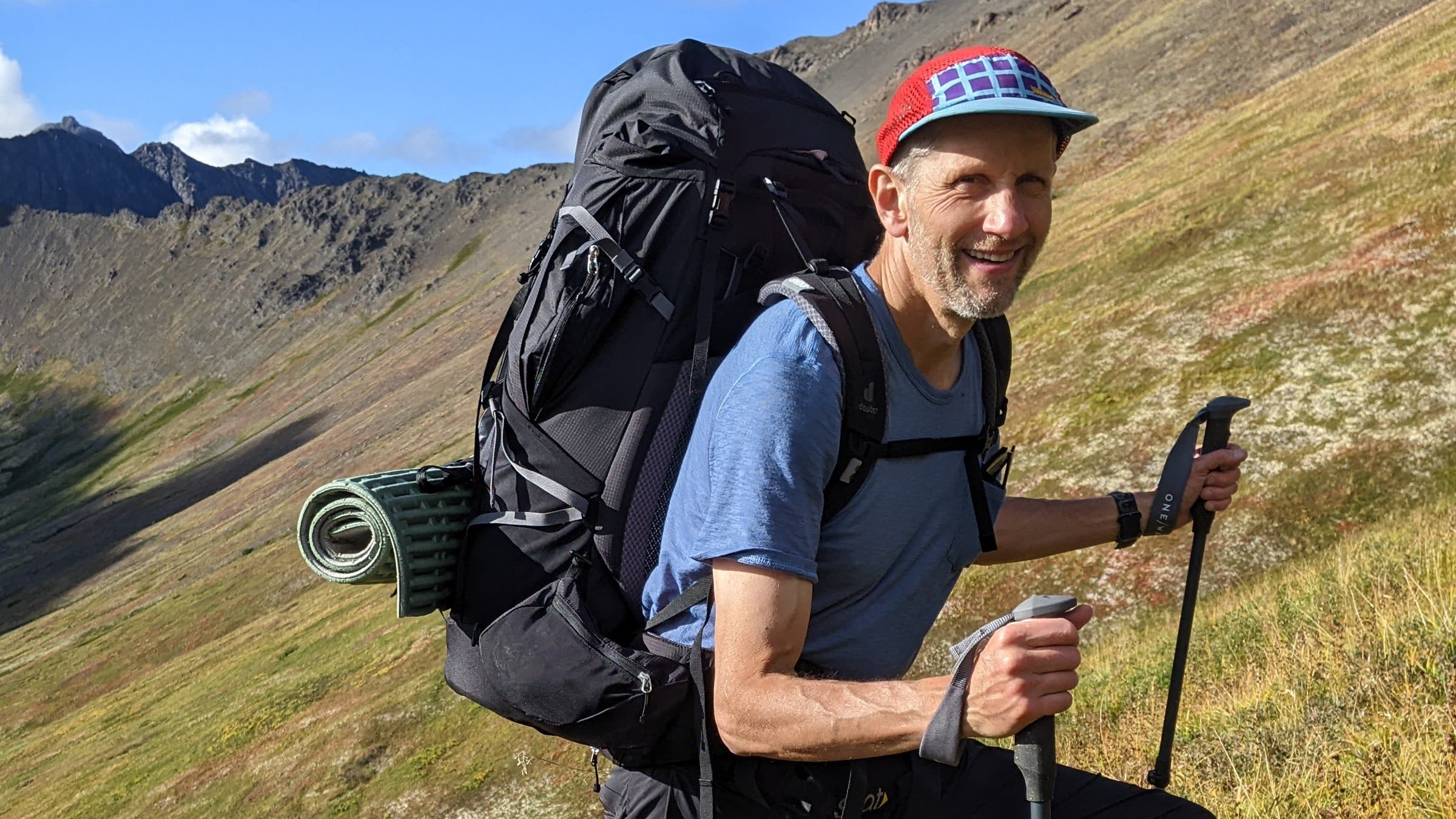
But it’s not all about burly carry. This beast’s got brains as well as brawn: Clever details range from a removable, accordioning water bottle pocket on the hipbelt to an easy-adjust backpanel that relies on carabiners instead of Velcro. Included straps turn the toplid into a daypack for side trips, and the built-in raincover gave testers much-needed protection against Alaskan squalls. Removable hipbelt pockets and four side pockets (two zippered, two stretch-mesh) keep on-the-go items handy, and a U-shaped external zipper let us grab layers from the main compartment without having to go spelunking. The organization doesn’t stop there, either: the packs’ internals include a zippered valuables pocket, a sleeping bag compartment, and a three-liter hydration sleeve.
Some testers loved all the organization. Others found it poorly thought-out. The side pockets were difficult to get into when the pack was fully loaded, and the belt pockets, while roomy, stuck out more than an inch from either hip. “They’d definitely get in the way if fully loaded,” one tester said.
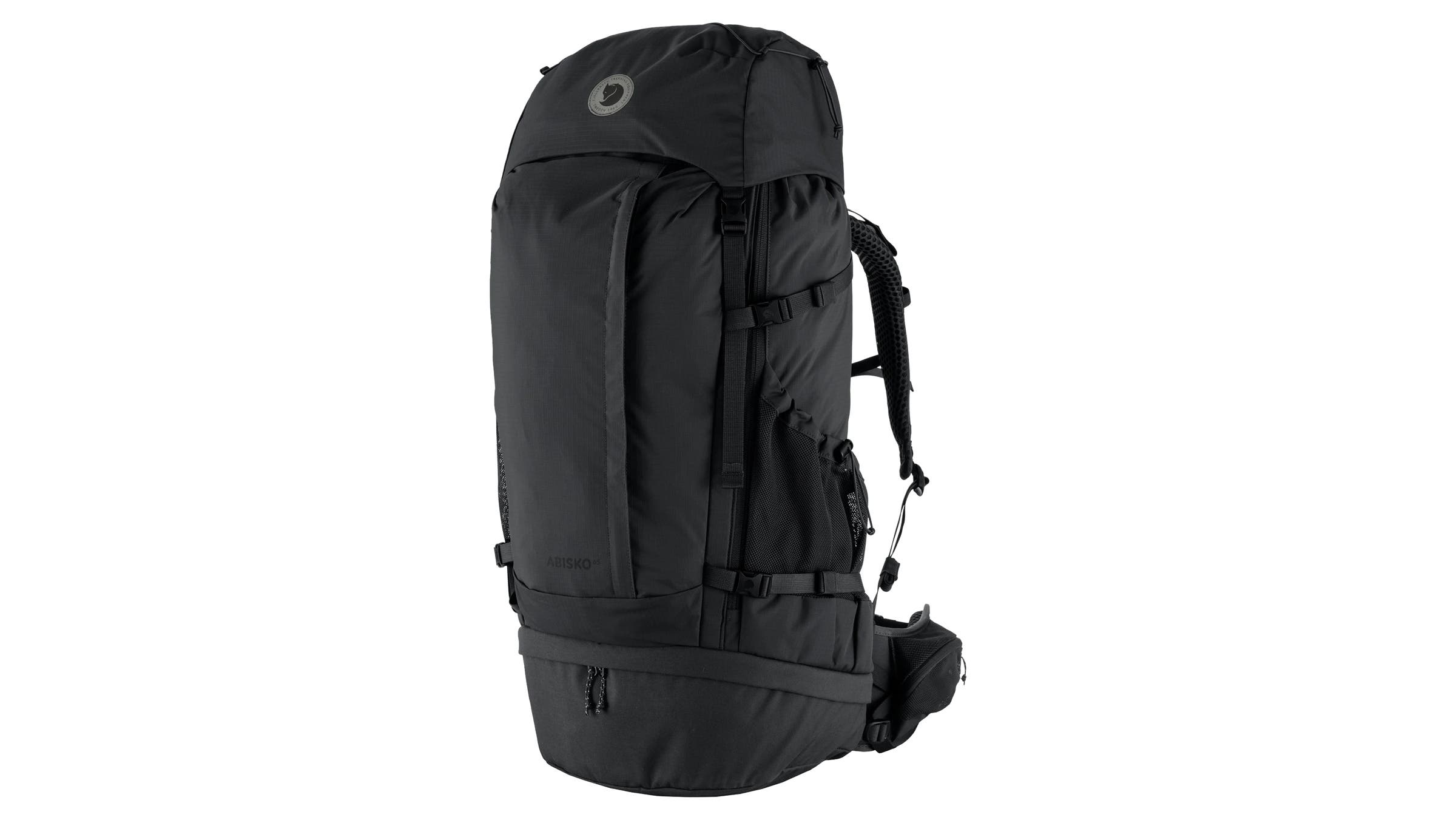
Most Eco-Friendly
Fjällräven Abisko Trek 48
Lab-Tested Weight: 3 lbs, 12 oz (men’s S/M)
Lab-Tested Volume: 74.2 L and two 1 L water bottle pockets
Lab-Tested Comfortable Load Capacity: 40 lbs
Sizes: Unisex S/M-M/L
Pros and Cons
+ Top-notch durability
+ Excellent load carry
+ Tons of pockets
+ 100-percent recycled materials
– Poor breathability
– Heavy
While most packs contain some recycled fabric these days, it’s rare to find one like the Abisko Trek 48, which is almost entirely made of post-consumer waste. And while the green materials and PFAS-free waterproof coatings gave the pack a leg-up on the eco-friendly front, its durability is what put it on our radar.
The 100-percent recycled 210-denier ripstop nylon body fabric withstood several miles of shimmying through overgrown plum bushes and willows in the Western Colorado backcountry, and we were able to sling the burly, 100-percent recycled, 500-denier nylon canvas base on sharp granite talus without worrying about puncture wounds. Even after five months of testing, the pack shows no signs of wear.
Thick webbing, heavy-duty buckles, and high-denier fabrics add weight, but they mean this pack is likely to last a lifetime. In other words, you won’t have to toss it in a landfill (or buy a new one) any time soon. And while the waterproof coating will likely need to be refreshed after a few years (most PFAS-free coatings do), we found it kept our gear dry during short squalls in the Rockies.
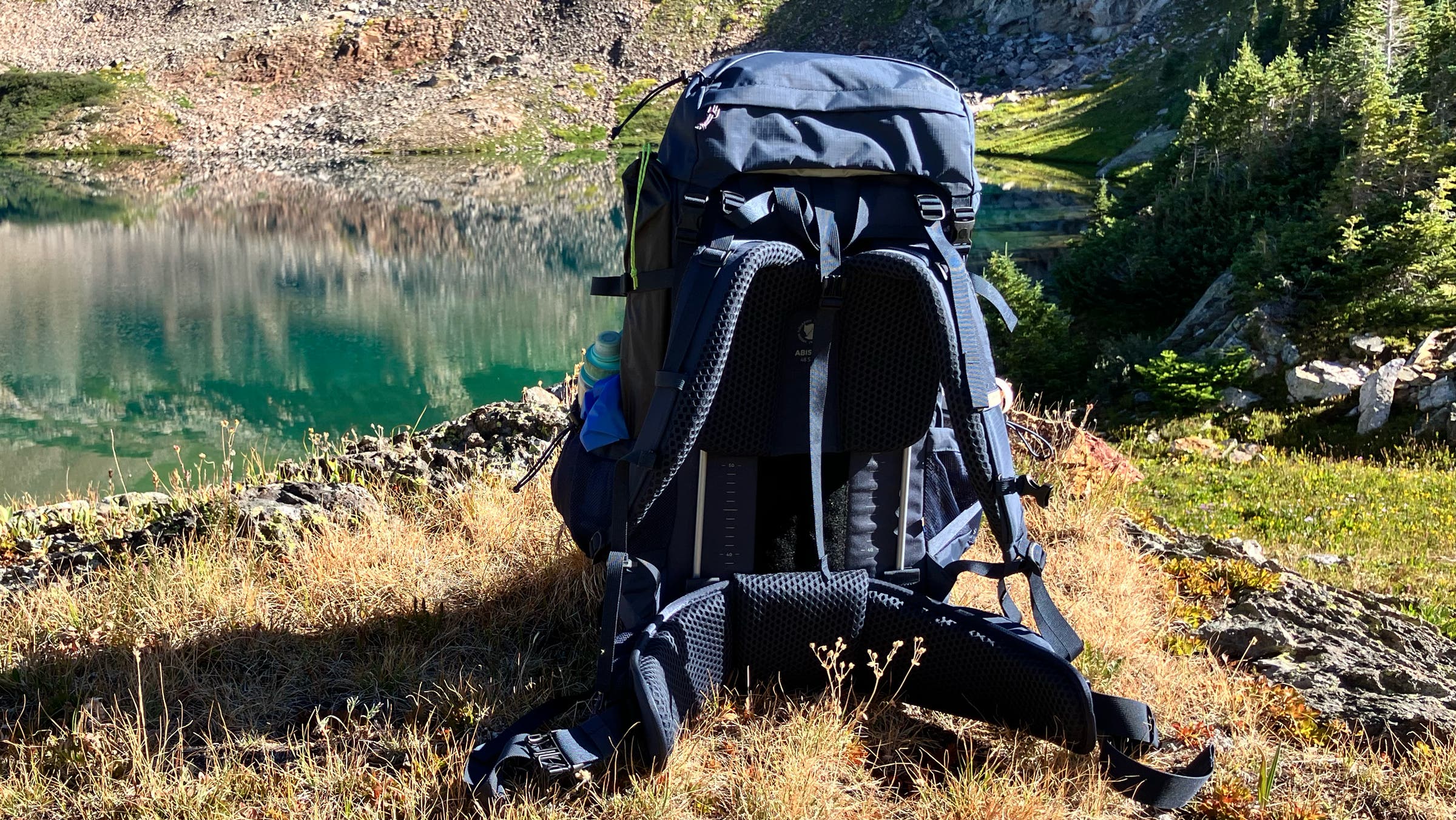
The aluminum frame is shaped like an inverted U, transferring loads to either side of the floating hipbelt. The system was robust enough to support up to 40 pounds, though it did sway slightly on more technical terrain. And while the cushy backpanel wasn’t the most breathable in 70-degree conditions, testers didn’t have any other complaints about comfort: five-inch-wide hipbelt wings securely wrap the iliac crest, and an inch-thick layer of EVA foam pads both the lumbar and shoulder blades.
This was one of the most comfortable packs we tested this season. One tester schlepped about 25 pounds of overnight gear up Treasury Pass near Crested Butte, Colorado, and the pack hugged her body the whole time. No swaying, no hot spots. We also loved the organization, which includes two cavernous zippered hipbelt pockets, a full-length dorsal zipper pouch, a removable toplid, and dual mesh water bottle pockets, which each fit a tent fly or poles. Front- and bottom-access zippers made it easy to set up camp in wet weather, or quickly grab raingear on the fly.
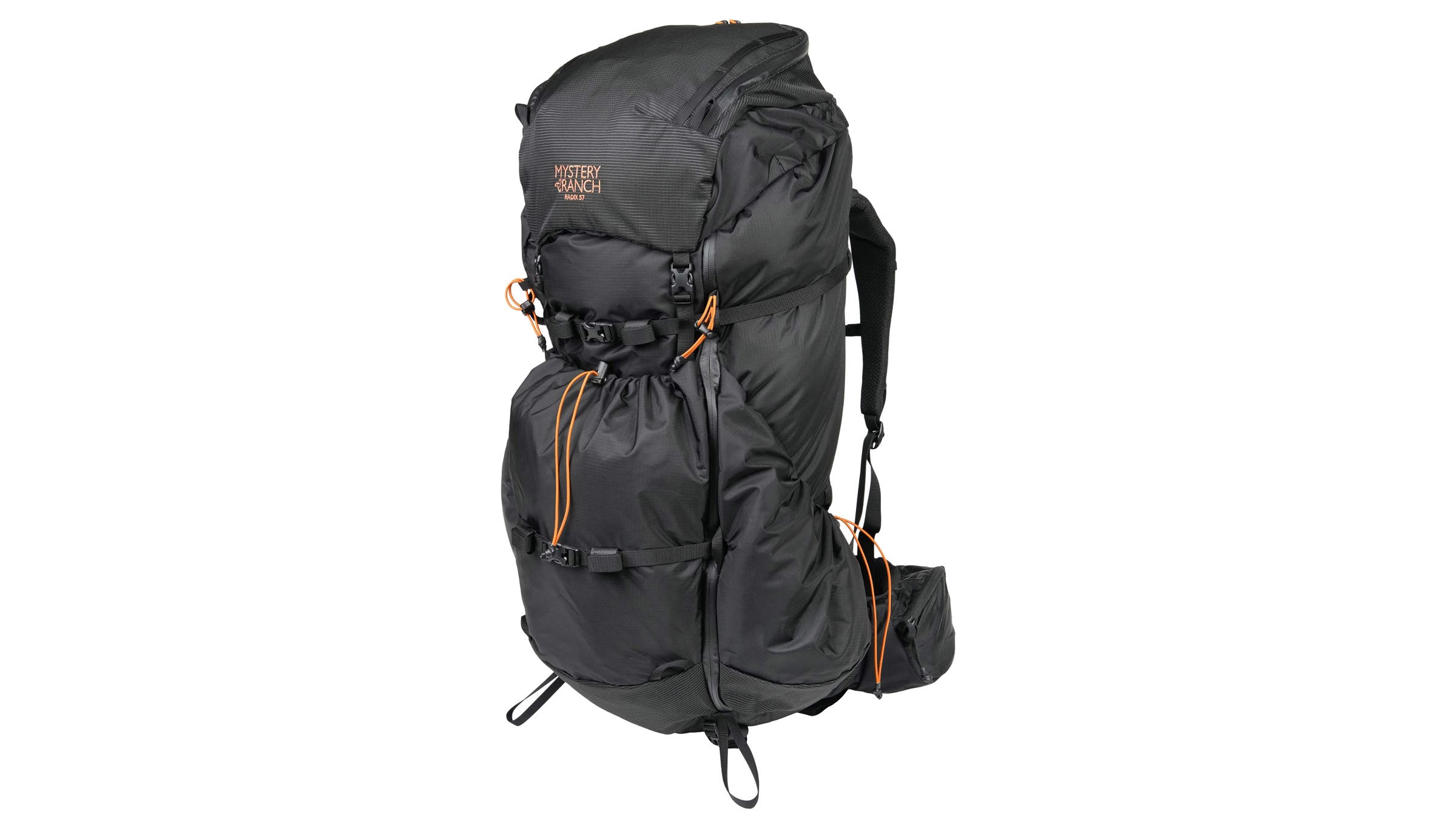
Best Organization
Mystery Ranch Radix 57
Lab-Tested Weight: 3 lbs 14.5 oz (men’s M)
Lab-Tested Volume: 67.5 and two 1 L water bottle pockets
Lab-Tested Comfortable Load Capacity: 50 lbs
Size: Men’s S-XL and women’s XS-L
Pros and Cons
+ Best-in-test gear access
+ Superior load carry
+ Great carrying comfort
– Tiny hydration sleeve
The Radix 57 doesn’t just look sexy with its sleek monochrome fabric and tantalizing, full-length side zipper. It also delivers best-in-class comfort, load carry, and gear access all in a sub-4-pound package.
Organization is outstanding for a lightweight pack: an off-center, full-length zipper flays the bag open nearly flat, making gear access and camp setup a breeze. The waist pockets each fit a smartphone, and large lateral pockets are angled for easy access while hiking. Want to go even lighter? The roomy toplid, compression straps, and frame are all removable, allowing it to function as a breezy overnight pack; the Radix 57 weighs just 3 pounds stripped.
The secret to providing all those features at a featherlight weight? Mystery Ranch’s use of high-quality materials. On the outside, a strong-but-gossamer 100-denier Robic nylon is reinforced with a grid of ultra-high molecular-weight polyethylene (UHMWPE), a uniquely strong and waterproof thread. While the pack itself isn’t seam-taped—and therefore isn’t waterproof—the use of the UHMWPE makes it highly water-resistant as well as abrasion-resistant. “I’ve squeezed under large blow-downs and past grabby bushes and trees,” reported Washington-based tester Matt Wise. “The pack hasn’t been phased.”
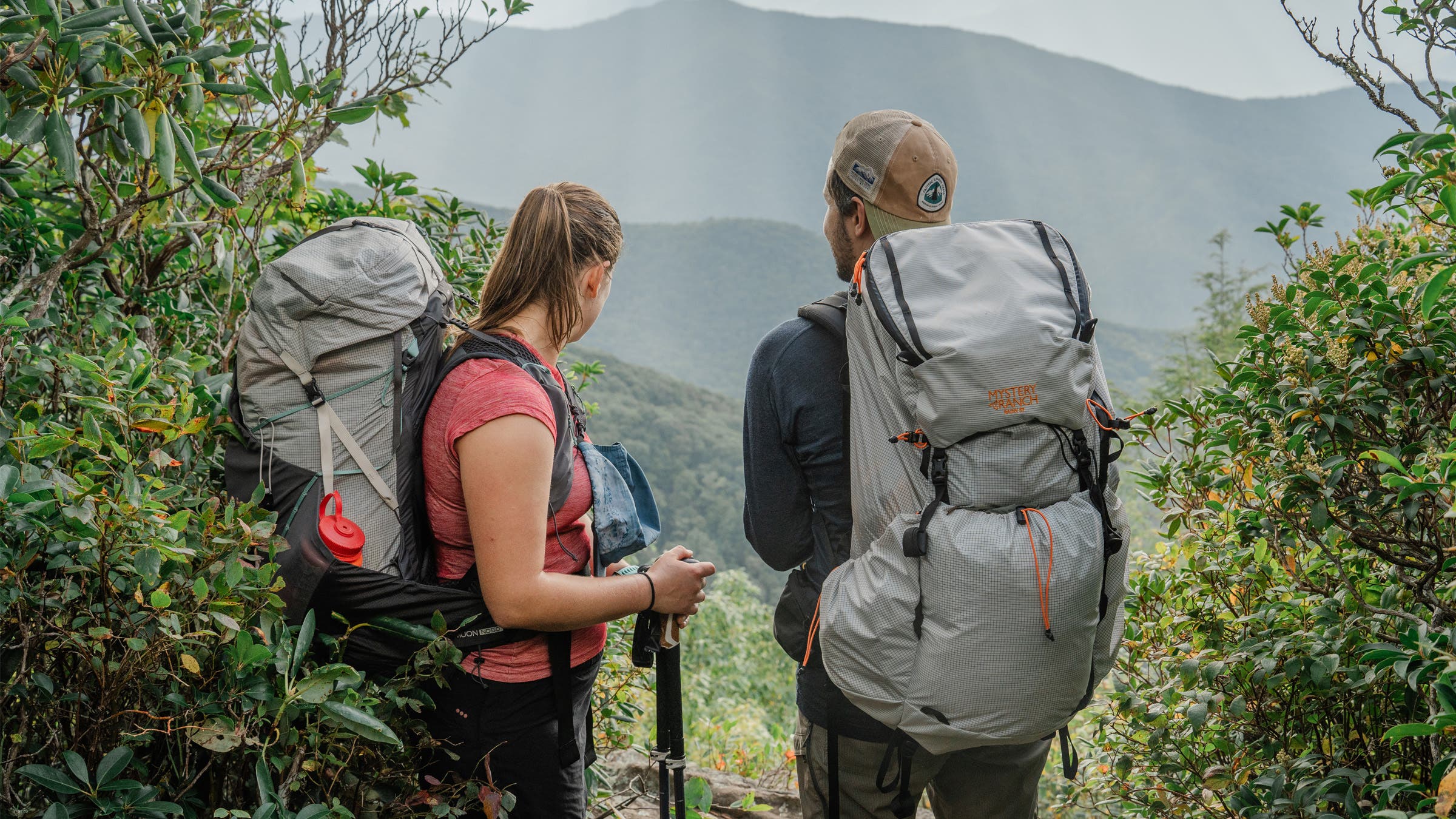
On the inside, a 7000-series aerospace-grade aluminum frame keeps loads close to the back. The frame, which is lightbulb-shaped and contoured to match the spine, provides both vertical stability and adequate torsional flex to support a natural gait. Load lifters and a cushy hipbelt further boost comfort. As a result, testers were able to heft up to 50 pounds without soreness. (While there are other UHMWPE packs that can carry up to 60 or 70 pounds, most cost twice as much.) “It’s become my go-to for three- to four-day trips,” says Wise.
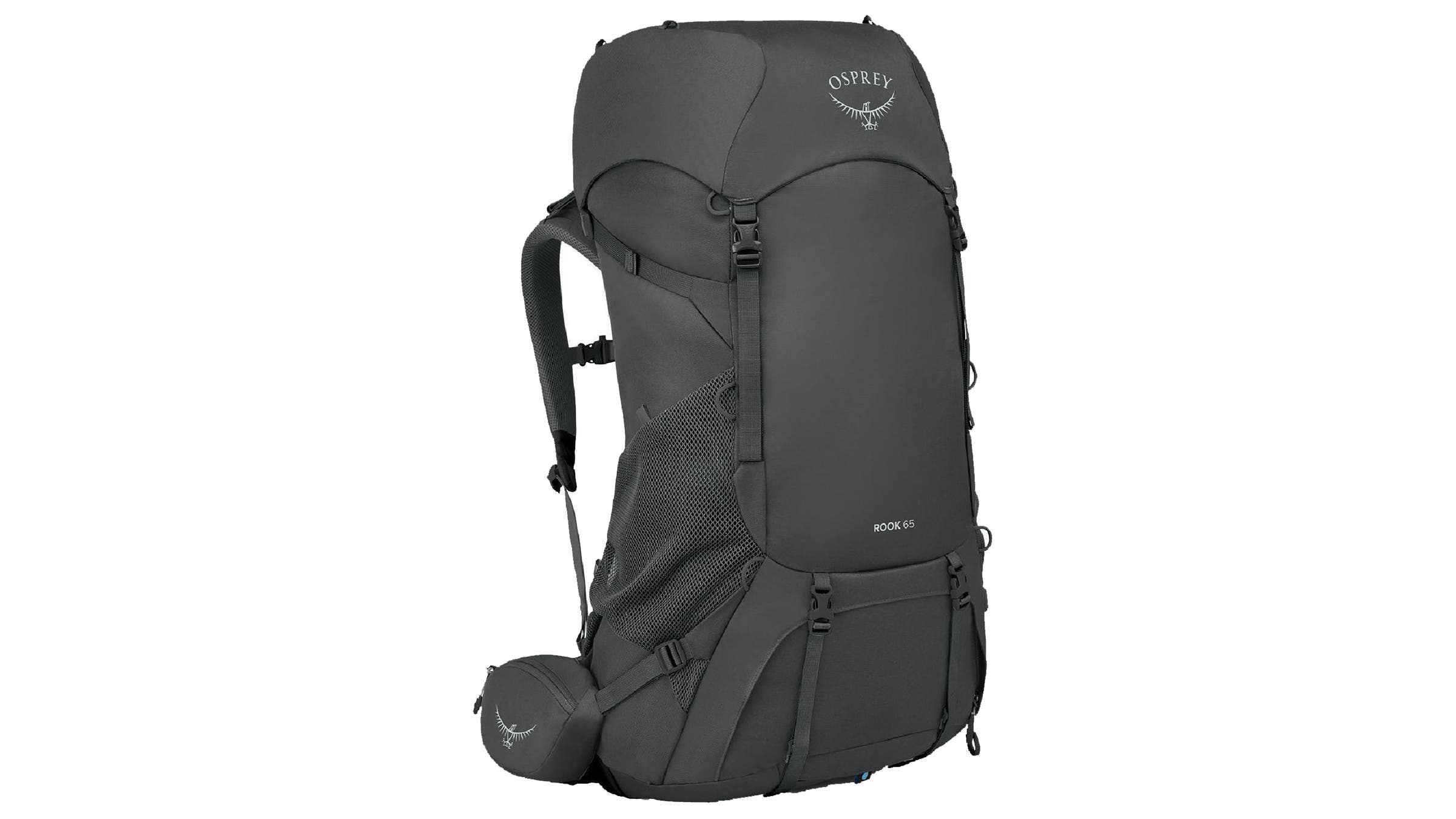
Best for Bigger Bodies
Osprey Rook/Renn 65L Extended Fit
Lab-Tested Weight: 4 lbs 9 oz (Rook)
Lab-Tested Volume: 63 L and two 1 L water bottle pockets
Lab-Tested Comfortable Load Capacity: 35 lbs
Size: M’s and W’s, one size each
Pros and Cons
+ Adjustable backpanel
+ Included raincover
+ Good load carry
+ Affordable price
– Subpar breathability
Most plus-size backpacks feel like an afterthought, but the Rook/Renn 65 EF was specifically designed for the needs and nuances of bigger bodies. The hip pockets are positioned to remain accessible even with the waist belt extended to its full 70 inches. Likewise, the harness padding is extended and contoured to comfortably wrap broader shoulders and waists.
Though the Rook/Renn 65 EF only comes in a single size for each gender, it sports four inches of torso-length adjustability. Testers found the adjustment system—two parallel ladders with plastic toggles—easy to manipulate. And testers of all sizes felt that the 4-millimeter aluminum perimeter frame let them carry extra-heavy loads. “I packed about 45 pounds of gear to an alpine hut,” says Diandra Oliver, a tester based in British Columbia. “I had plenty of room left in the bag and could have carried more.”
She also lauded the plentiful organization, which made it easy to quickly stuff gear for an early start. Deep bottle pockets, a massive toplid, and a stretchy dorsal sleeve swelled to fit extra layers. A 3-liter hydration sleeve and included raincover round out the features.
The only downside was breathability: the backpanel’s mesh trampoline is hourglass-shaped, which means that larger bodies tend to block airflow on either side of the mesh. As a result, testers ended humid hikes in the Adirondacks soaked with sweat.
So far, the pack’s burly 600-denier recycled polyester has defied scrapes even after a season of bashing. “I threw it on rocks and packed my axe inside with a cereal box for a blade cover,” Oliver reports. “No holes or wear.”
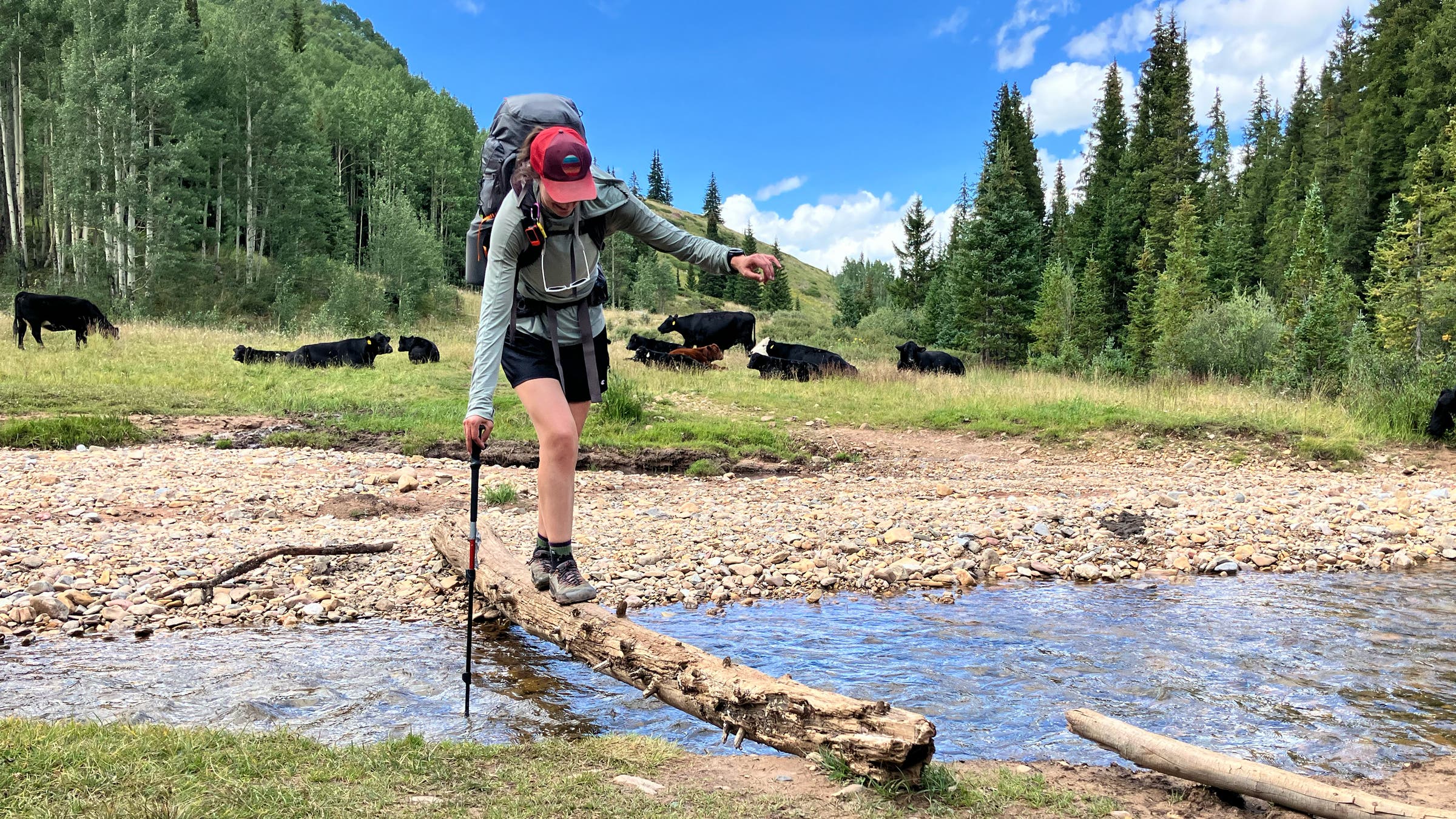
How to Buy a Backpacking Pack
Your choice of pack can make the difference between a life-changing trip and a miserable one. Here’s how to choose.
1. Capacity
The first step is to determine what kind of capacity you need. For one- to three-night trips, target 40 to 55 liters. For gear-intensive trips or those nearing a week in length, you’ll likely need 60 to 70 liters. When you go shopping, bring your full kit—clothes, water, sleeping bag, tent, the works. Make sure it all fits in the pack before you buy.
2. Fit
No discount is worth sacrificing your comfort for. Before you buy, have a gear shop employee measure your torso length (the distance from the vertebra at the base of your neck to the point midway between your iliac crests). Most people are between 16 and 21 inches. Make sure this number falls within the range of your prospective pack’s specs. Then, try it on. Swing your arms, rock your head back, and leap around. The pack should feel snug but not too tight, and it should move with your body without impairing motion.
3. Load-carrying capacity
How much can your pack comfortably carry? Lightweight and ultralight packs may look sleek, but many cap out around 25 pounds—a tough weight to achieve if you prefer a few creature comforts. Beefier packs can often tote up to 50 or 60 pounds, but they also weigh more when empty.
4. Features
Now consider your backpacking style. If you like to snack on the go, prioritize hipbelt and chest pockets. If you’re a reservoir person rather than a bottle person, make sure there’s a built-in hydration sleeve and hose port. If you plan to carry an ice axe or trekking poles, look for stowage loops. Your preferences may change over time, but make sure your pack meets your basic needs.
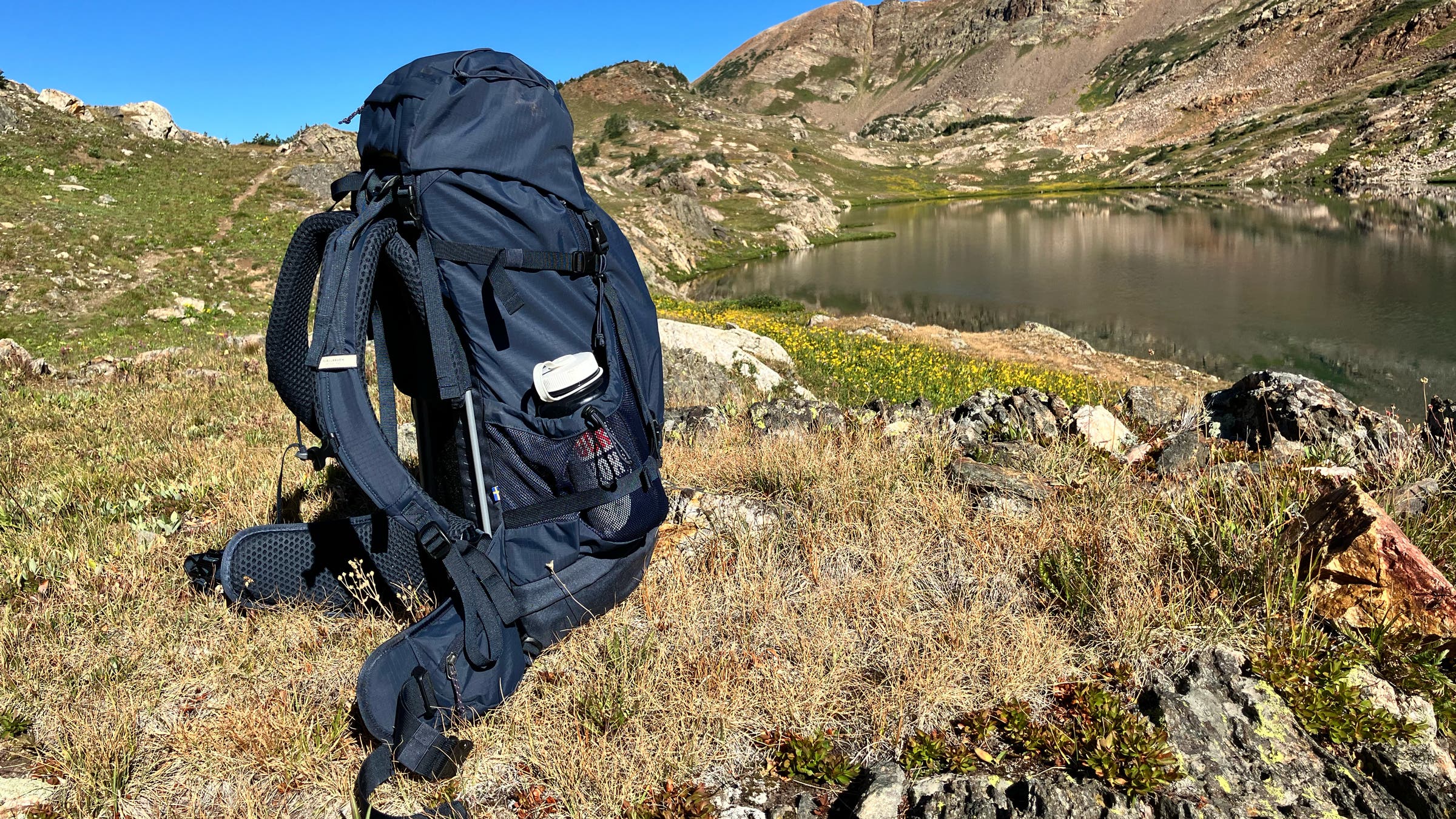
How We Test Backpacks in the Field
- Coldest temp: 34 degrees F (Tromso, Norway)
- Hottest temp: 100 degrees F (Zion National Park, UT)
- Highest elevation: 14,238 (Capital Peak, CO)
- Highest winds: 50 mph (Dolomites, Italy)
- Heaviest load: 60 lbs
- Longest day: 17 mi
Backpacking packs are among the toughest items to fully test within the course of a season. They’re more complex than apparel, they take longer than boots to show their pain points, and all the bells and whistles can take dozens of miles to evaluate. That means each pack needs at least two testers and 50 to 100 miles on the trail at a minimum.
Every testing season is a madcap race to drive as many packs into the ground as fast as we possibly can. Samples usually start trickling into the office in July. From then on, it’s a game of hot potato: we rush to ship them to our hardest-charging testers. When one trip ends, the pack flies back to the post office and into the hands of the next tester.
This year, we evaluated 13 brand-new multiday packs and compared them to a dozen top-performing packs launched in previous years. We eliminated models without technical features, load-bearing hip belts, or suspensions appropriate for their carrying capacity. From there, we distributed our candidates to 17 testers across seven states and eight countries—as far as Canada, Alaska, Thailand, and Norway.
Those that broke, tore, or left our testers aching were either re-tested or cut from the running. Those that lightened loads, kept us moving, or made us forget we were wearing packs at all, you’ll find listed here.
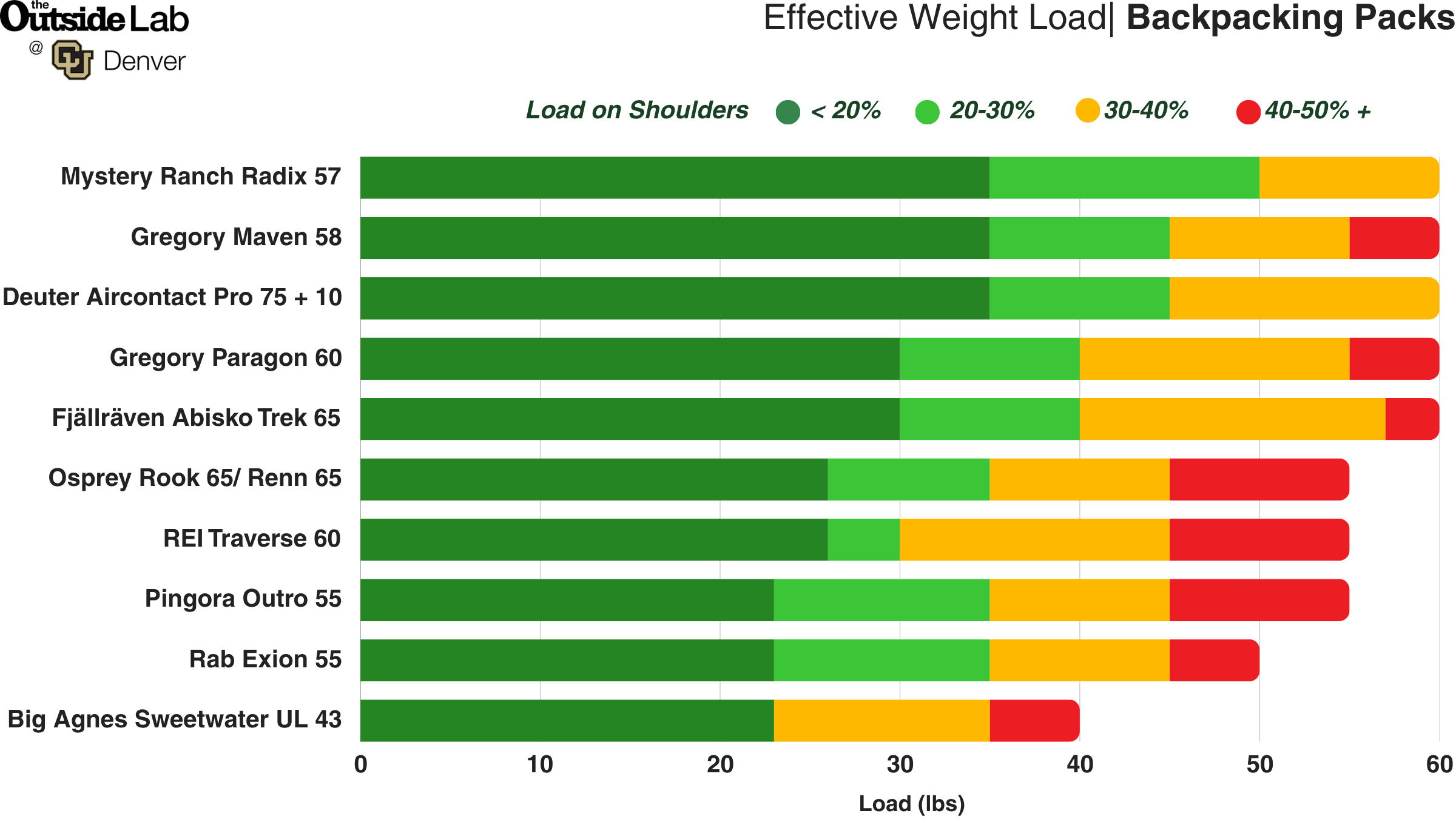
How We Test Backpacks in the Outside Lab
Volume measurement
Volume is measured using the ASTM F2153-07 standard, which calls for filling pack compartments with uniform, 20-millimeter-diameter balls (roughly half the size of a ping pong ball). The number of spheres crammed into each pocket is counted to give a value for the volume in liters. We start with the main compartment. Once it’s 100-percent full, we fill and measure the other compartments: water bottle pockets, lid, hip pockets, stretch mesh on the front, and all other external pouches. This gives us a total measured volume to verify pack size, and show where that volume is stored. All pockets were considered at capacity when they could no longer be properly closed—zipped fully, top drawstring closed to a maximum remaining diameter of 2.5 inches, or 2 rolls/folds and buckling for roll-top bags. The lab works to a modified version of the standard by measuring all pockets—the standard excludes open and mesh pockets, and pockets smaller than 4L—because we feel it’s important to include every nook and cranny available.
Weight capacity
When fitting a pack loaded with your gear, it’s best to follow the “80/20 Rule”—80 percent of the load on your hips, and 20 percent carried on your shoulders—for the most comfortable trail experience. Every pack has a maximum load it can carry, typically when the majority of a pack’s weight is hanging off your shoulders rather than the hipbelt. But it doesn’t go from comfortable to complete failure in a heartbeat: All packs lose their capacity to transfer weight to the hips progressively. The point at which comfort starts to wane (since comfort is subjective, we use total load percentage) is the “effective weight load” and is a good baseline to consider when choosing a pack to meet your needs.
To test effective load, we outfitted mannequins with flexible force sensors and then fit each pack with the hip belt tightened, torso adjusted, and load lifters (if available) properly tensioned. Starting at 15 pounds, we added 5 pounds at a time while recording the force on the shoulders and paying attention to any sign of the hip straps slipping. Sleeping pads were placed at the bottom of the bag before loading heavier weight to simulate an actual backpacking pack. Side compression straps were tightened when necessary to center the weight against the back of the mannequin and keep it from sagging outward. Packs were loaded to a maximum of 60 pounds if they didn’t fail at an earlier load. It’s important to note that our test is for static load (doesn’t move around), and can’t account for how a pack’s design/frame affects the feel of the load when on-the-go. For example, a pack with a suspension back panel may perform well in the static load test, but feel off-balance with a heavy load when moving.
A result of 20 percent or less of the total load on the shoulders is the ideal carry, while 20-30 percent is still a comfortable carry. A load on the shoulders that’s 30-40 percent of the total weight is less ideal, and might cause some soreness over long miles, especially with heavier packs. At 40-50 percent: Your pack is beyond weight capacity, painful to carry, and will put stress on pack components, potentially leading to a snapped buckle or strap. —Adam Trenkamp, Outside Lab Test Editor
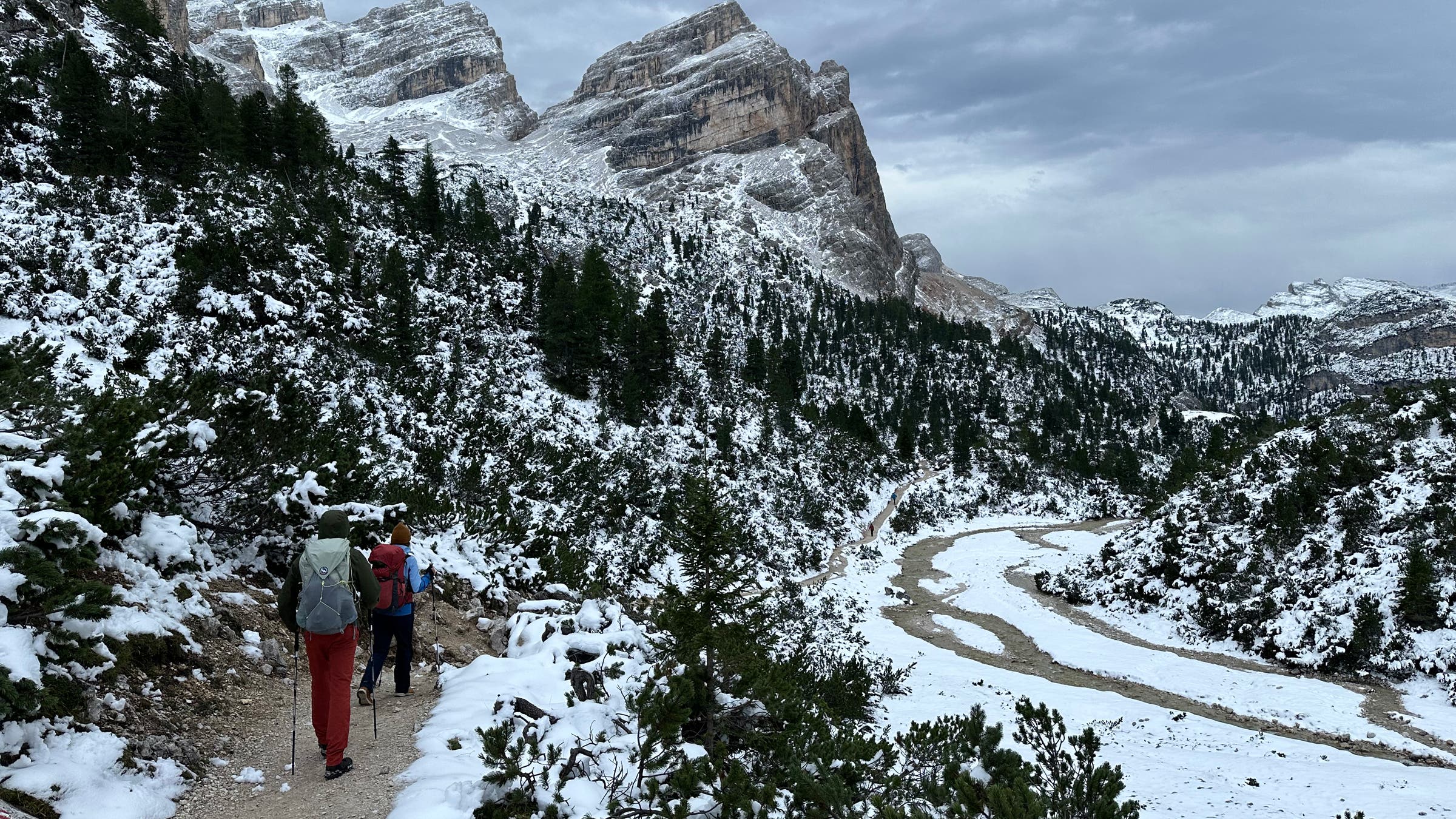
Meet Our Testers
Corey Buhay is a former Backpacker editor and co-author of the hiking guidebook Colorado Rockies. She is currently based in Boulder, Colorado. She’s been managing the packs category for Backpacker since 2019, and has developed very strong opinions about hipbelt pockets.
Samantha Cooke is a gear tester and trekking guide based in St. George, Utah. When we need a pack scraped up in slot canyons, loaded up with bulky group gear, or pushed to its absolute limits, this is who we call. When she’s not guiding, Samantha is usually rock climbing, backcountry baking, or exploring Southern Utah’s canyon country.
Dorn Van Dommelen is the ringleader of a family of gear testers based in Anchorage, Alaska. He’s infamous for his ability to put holes in even the most durable packs via rigorous multiday bushwhacks in the Alaskan backcountry. Van Dommelen is currently a professor of geography and anthropology at the University of Alaska, Anchorage.
Related
The Best Men’s Hiking Boots and Shoes
The Best Men’s Rain Jackets
The Best Ultralight Tents